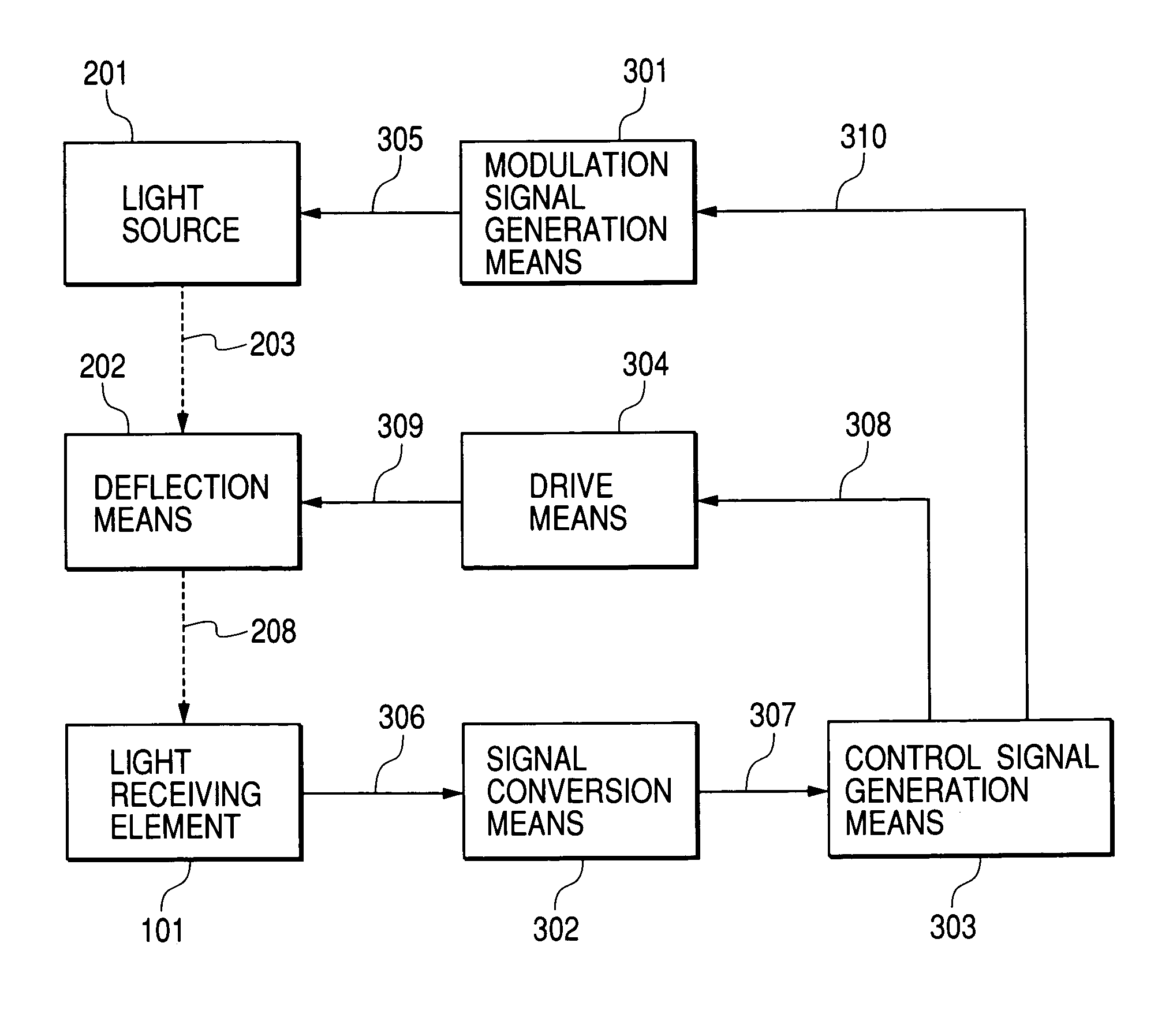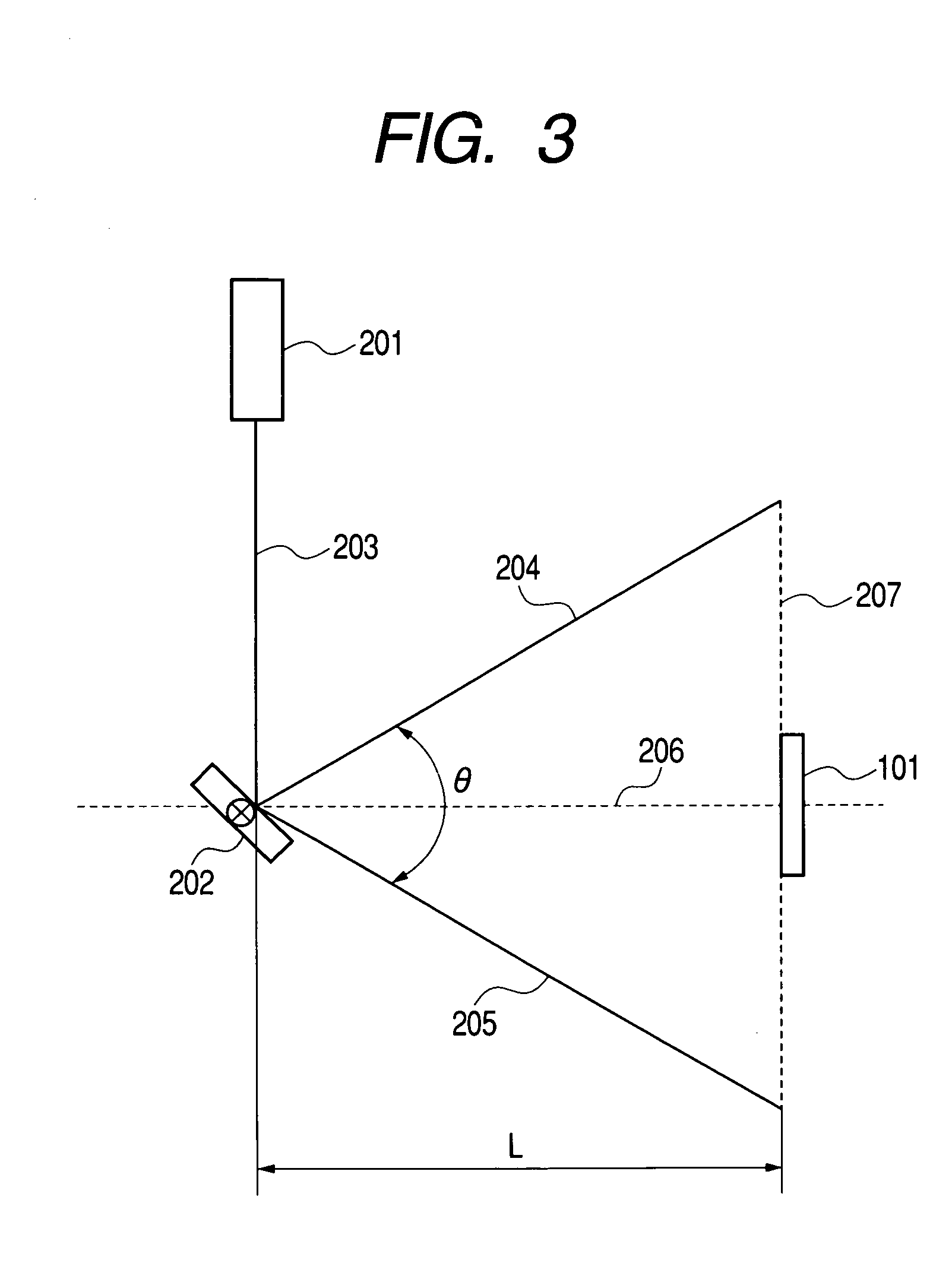Optical deflector
a deflector and optical technology, applied in the field of optical deflectors, can solve the problems of signal delay in the detection circuit, timing errors, and inability to control the angle of deflection and keep it to a constant value, and achieve the effect of accurate control of the operation of the deflector
- Summary
- Abstract
- Description
- Claims
- Application Information
AI Technical Summary
Benefits of technology
Problems solved by technology
Method used
Image
Examples
first embodiment
[0035]The inventor of the present invention came to have an idea of utilizing deflected beams of light that are emitted from a light source and deflected to reciprocate for scanning by a deflection means that also reciprocates (swings), for controlling at least either the light source or the deflection means.
[0036]More specifically, according to the invention, deflected beams of light moving forward and moving backward are detected by a light receiving element and either the deflection means or the light source is controlled by way of a control means in such a way that the distance (displacement) between the position of the forwardly moving deflected beam of light and that of the backwardly moving deflected beam of light, each at a given clock time, shows a predetermined value.
[0037]FIG. 2 is a schematic illustration of scanning of beams of light that are deflected (reflected) by the deflection means of the first embodiment of optical deflector so as to reciprocate on a light receiv...
second embodiment
[0095]This embodiment differs from the first embodiment in terms of the method for identifying the position (central position) of each of the modulated and deflected beams of light (modulated spots) on the light receiving element 101 comprising a plurality of light receiving regions 105. Otherwise, this embodiment is identical with the first embodiment.
[0096]FIGS. 6A, 6B and 6C are schematic illustrations of the second embodiment.
[0097]FIG. 6A shows the positional relationship of the position on the light receiving element 101 where a modulated spot is formed and the plurality of light receiving regions 105. Note that the scanning direction is horizontal on FIG. 6A. For the purpose of simplicity, assume here that there is a single modulated spot on the light receiving element 101. For the purpose of the invention, the process that is described below may be repeated for the number of times that is equal to the number of spots that is involved in the optical deflector.
[0098]FIG. 6B is...
third embodiment
[0106]This embodiment differs from the first and second embodiments in that the light receiving element 101 has a plurality of light receiving regions 105 that are two-dimensionally arranged. Otherwise, this embodiment is identical with the first and second embodiments.
[0107]FIG. 7 is a schematic illustration of a plurality of light receiving elements that the light receiving element of the third embodiment includes.
[0108]As shown in FIG. 7, the light receiving element 101 has a plurality of light receiving regions 105 that are arranged two-dimensionally. In other words, the light receiving regions 105 have a square profile and are arranged in rows and columns.
[0109]When a plurality of light receiving regions 105 are arranged two-dimensionally as in the case of this embodiment, the distribution of quantity of light of a modulated spot can be detected two-dimensionally so that the profile of the modulated spot can be grasped accurately and a large quantity of data can be used for sel...
PUM
| Property | Measurement | Unit |
|---|---|---|
| angle of deflection | aaaaa | aaaaa |
| resonance frequency | aaaaa | aaaaa |
| diameter | aaaaa | aaaaa |
Abstract
Description
Claims
Application Information
 Login to View More
Login to View More - R&D
- Intellectual Property
- Life Sciences
- Materials
- Tech Scout
- Unparalleled Data Quality
- Higher Quality Content
- 60% Fewer Hallucinations
Browse by: Latest US Patents, China's latest patents, Technical Efficacy Thesaurus, Application Domain, Technology Topic, Popular Technical Reports.
© 2025 PatSnap. All rights reserved.Legal|Privacy policy|Modern Slavery Act Transparency Statement|Sitemap|About US| Contact US: help@patsnap.com



